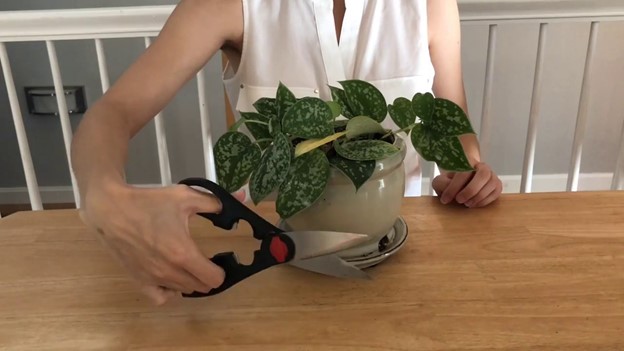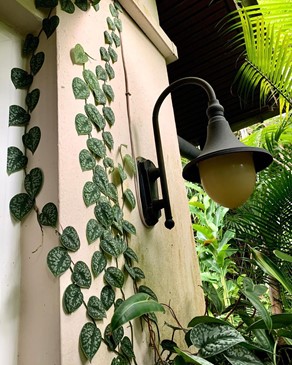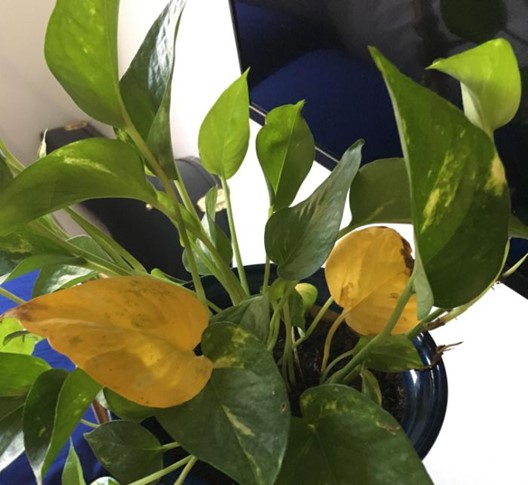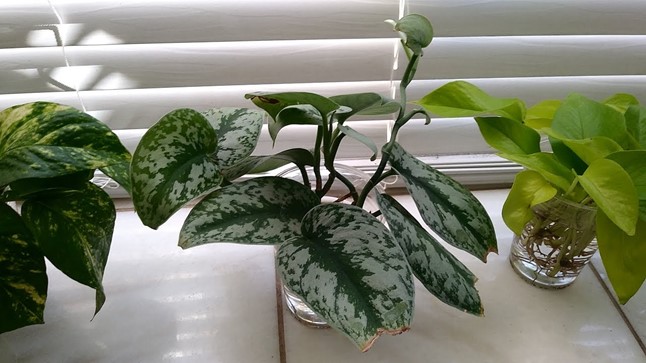Most plant owners are not professional gardeners and neither do they have such extensive knowledge about plants and how should one care for them and hence most of these people end up buying a potted plant that can be kept indoors because they think potted plants do not require much care and that is where they go wrong. Just because those plants are tiny and can fit in a small fancy ceramic pot, it does not mean that they do not need proper care.
So, on this note, today we are going to talk about how you can care for silver satin pothos, a very common houseplant. With the gorgeous splashes of white against the dark green leaves that are almost symmetrical. Satin Pothos is indeed a great houseplant.
More because if you care properly and provide everything that your plant needs in the beginning, it grows up to be a strong and tough plant that can last against rough conditions and is very low maintenance. But the question here is how can you do that?
Let us find out then!
Silver Satin Pothos – Introduction
Before we begin to understand how to care for a plant, it is crucial that we know more about the plant, its species, and the type of natural habitat it is accustomed to growing in.
Speaking of Silver Satin Pathos, it is basically a vine with extremely dark green leaves that have subtle silver linings and prominent splashes of white. Its scientific name is Scindapsus pothos and it is also known as silver pothos or silver vines. It belongs to the arum family Araceae. The plant is commonly found in India, Bangladesh, Thailand, and the Philippines.
This popular and low-maintenance houseplant is also known for its beautiful flowers. If you plant, it on the open ground it can climb up to 10 ft and are known as evergreen climbers.
Caring for A Silver Pathos
When it comes to caring for a plant and giving it enough nutrition so that it grows up strong and lives a long and healthy life, there are a lot of parameters that you need to consider planning out that perfect care routine. So below we will be discussing all the parameters that need to be taken care of and how exactly should you do it.
1. Light
Light is one the most important part of a plant’s growth and health. As we all know that plants prepare their food through photosynthesis and sunlight is one of the most crucial elements without which the process cannot be completed. The process of photosynthesis helps the plant product adequate food and energy that helps the plant survive.
For a Silver Satin Pothos, it needs bright sunlight throughout the year but makes sure that you do not place it somewhere where the harsh sun rays directly fall on the leaves. The direct sun rays can scorch the delicate leaves and destroy the chlorophyll within the leaves. Also, make sure that do not place it in a shady area because then the leaves will lose their variegation. Just manage to hit the sweet spot and provide just enough sunlight.
2. Watering and Its Frequency
Silver Satin Pothos just like any normal plant needs adequate water to survive. Watering it once a week is fine unless you live in a very dry region. Since the water required by your plant also depends on the region you come from, there is one easy hack to know the right time to water.
Just check the topsoil layer, if it has very little amount of moisture left then it is time to water your plant. Just make sure that you allow the topsoil to dry a little before you go for the second round of watering. Also, if you spot yellow leaves on your plant then that is a sign of over-watering.
Make sure you stop immediately in case you catch yourself overwatering your plants, the leaves will not only just turn yellow, but it can even kill your plant in the long run.
Also, make sure that you use room temperature water for your plant. In this way, you will eliminate the risk of shocking your plant or its roots with a sudden rise or fall in temperature. Also, cold water makes the pumping mechanism (the mechanism of pumping up water from roots to the leaves) less efficient whereas hot water makes it difficult for the plant to absorb oxygen.
3. Humidity
If you want a healthy plant, make sure that you maintain the humidity of the room to at least 40 to 50%. If you feel that the air is drier than that especially if you belong to a dry hot climate area, then you should also consider using a humidifier.
The reason behind this is that if the humidity level is low in the air, then the warm air surrounds the leaves will pull up the water from the plant, making them evaporate through the leaves until the air is saturated. This will lead to a decrease in the water level of your plant, the basic functions that they carry out to survive will be disrupted and your plant will die eventually.
Also, if the air around your plant is too humid, the excess water from your plant will not evaporate into the air which will lead to excess water that has the potential to rot the roots of your plant, turn the leaves yellow, and again eventually your plant will die.
4. Soil
One thing that you should keep in your mind if you want to make sure that your silver satin pothos blooms and flourishes well is that you will need to place it in well-drained soil. No matter what you do to take care of it and how many fertilizers you add, soil that locks in water will kill your plant. Because when placed in wet and soggy soil, the roots of satin pathos begin to rot very easily and once that happens there is nothing that you can do to reverse the damage.
Also, to add the requirement of well-drained soil, you also need to take care of the pot you decide to place your plant in. Whether you are planning to go for a fancy ceramic pot or a plain earthen pot, it is best to go with a pot that has a small hole carved at the bottom that will provide a way for the excess water to seep out and protect your roots from rotting.
Also, make sure you add equal parts of peat moss, potting soil, and perlite to prepare the perfect soil mix for your plant and if you feel that this is a lot of work to do, and you do not have the confidence or the skill to do it right then you can also go for a houseplant potting mix.
5. Temperature
The right temperature is another crucial part that is very important for the growth and development of a plant. For Silver Pathos, you should place the plant in a nice and warm temperature of about 65 to 85 degrees Fahrenheit or 18 to 29 degrees Celsius and make sure that the temperature does not fall below 60 degrees Fahrenheit or 16 degrees Celsius.
If the temperature is too high, the water loss will be so rapid that your watering frequency will not be able to compensate for it and the leaves will wilt, the process of photosynthesis will be disrupted, and the plant will lose all the resources that help it survive.
Whereas an extremely low temperature reduces plant enzyme activity to dangerous levels that will make it difficult for the plant to prepare its own food or do other activities like breaking down and distributing the food prepared before, stunting your plant’s growth, and eventfully your plant will die.
6. Pruning

This is a very basic thing that not just Satin pathos but every plant needs. Pruning helps you keep your plant in shape which is very essential especially because houseplants are an excellent piece of décor as well and Pruning helps you get rid of the old and dead plant parts that can sabotage the healthy parts of the plant.
7. Fertilizer
Sure, all the above things are essential and will eventually help you grow your plant and give it a long healthy life, but nothing can substitute the need for proper fertilizers. No matter what good care you take of your plant, but you will need the right fertilizer to make sure that it grows to its fullest potential.
Hence, every 4-6 weeks during its growing period you need to provide a balanced 10-10-10 or a 20-20-20 water-soluble fertilizer that has been diluted by half.
Things to Know Before Buying A Satin Pathos
Now that we have completed the list of things that you need to take care of to promote the healthy growth of your plant and give it a long and healthy life, there are a few things that you need to know before you buy a silver satin pathos.
1. They Are Toxic
This might come as a disappointment to you, but we cannot help but face the fact that silver satin pothos is toxic and can be extremely fatal for kids and pets, especially cats. The poison is contained in the form of calcium oxalate crystals in the raphides which when chewed spills out the calcium oxalate in your stomach and poisons you. There is nothing you can do to stop this except being a little more cautious with this plant especially if you have kids or pets at home.
2. Repotting Them Is Important
Repotting them every one or two years is a great idea depending on their overall growth in those past two years. The only purpose of repotting is to give your plant a bigger space in case it has grown too big for its previous pot.
Make sure that your plant absolutely needs a new pot and only then shift because repotting basically includes shifting the plant to a bigger pot and unless your plant has grown and it really needs that extra space, repotting it can be a bad idea because the bigger pot will have a much larger capacity of holding water which will make it the roots rot easily if proper drainage is not provided.
3. Prone to Diseases and Pest
As we mentioned before, the roots of silver satin pothos are quite prone to rotting at the slightest exposure to excess water, it is also very prone to getting diseases and pests quite easily. Especially spiders and mites that can ruin the plant and even lead to its death.
So, make sure that you keep checking your plant for a possible pest invasion and take an immediate step at the slightest hint and to avoid all these problems, just ensure good drainage for the plant and the soil and you will be good to go.
Benefits of Having A Silver Satin Pothos
Do not let these minor issues dishearten you because having a silver satin pothos plant is amazing! Not just because it is a spectacular décor item but also because it has several scientifically-proven benefits that are good for you and your family. Let us start with them one by one.
1. It is A Low-Maintenance Part
Let us start with a much obvious point. Who does not like to have some greenery in their house, but most people take a step back fearing the immense hard work that goes behind maintaining a healthy tree but that is not the case with satin pothos? Once you have succeeded in planting the plant, it can grow without much are and can even withstand rough conditions.
Let us say you are not able to provide the optimum temperature, humidity, or water to the plant, unlike other delicate plants, it will not wilt and die. In fact, it will go through a tough period. But do not take this as an excuse to persistently neglect your plant because continuous negligence can harm your plant and even lead to its death.
2. It Also Acts an Air Purifier
What if we told you that is a gorgeous and easy to maintain plant that also comes with an amazing quality. Do you know what that is? A silver satin pothos also acts as an air purifier and cleans you are the air inside your home and makes it free of various toxic gases like excess carbon dioxide, and ozone and provides pure air for you, and your family to breathe in.
3. It Has A Calming Effect
In a recent study that was conducted among 14 Japanese men, it is found that touching the leaves of a silver satin pothos has a calming effect on the person. The exact psychological reasoning behind this is still not clear though. Also, it is believed that silver satin pothos is one of those plants that help you sleep at night better when they are placed in your room.
4. Does not Die Easily
Another very common name of this plant is Devil’s Ivy; it is called so because it is hard to kill. No matter what condition you keep it in, it does not give up easily and despite less water, sunlight, or unfavorable temperature, it will strive and stay alive. This is a huge advantage for people who have a busy schedule and cannot devote a lot of time to their plants.
5. A Great Item for Indoor Décor

This is not really a scientific fact but plants that satisfy your love for greenery, as well as act as an amazing décor element, are a pure blessing. The unique design of white splashes on dark green makes the plant stand out and its waxy texture gives off a shiny reflection and hence these perfectly heart-shaped leaves are in such huge demand. Another striking feature of this plant that adds to its popularity is that you can use it both as a small and sweet potted plant as well as a fantastic climber. Silver satin pothos can act as both.
6. Feng Shui and Vastu
While the presence and authenticity of Feng Shui and Vastu is a highly debated topic but a lot of people who believe in them might find this point interesting. In many regions like India and Bangladesh, this plant is also known as the money plant and it is believed that the presence of this plant in your house and brings wealth to the family and makes you richer. It is also believed that this plant, brings in good luck, positive energy and prevents any type of negative energy from entering the house.
Common Diseases/Problems Faced by Silver Satin Pothos
1. Rotting Roots
We have mentioned the plant’s over-sensitivity to excess watering countless times in this post and here we go again. Rotting roots is one of the most common problems that these plants face. The only way to make sure that this problem does not occur with your plant is to water it only when you can see that the soil is dry. The biggest issue with the rotting roots is that you will not get an early sign and when you can see the rotting roots there is already an extensively damaged root system under the soil.
2. Yellow Leaves

This is another common problem that also happens due to excess watering and to prevent this you will have to follow the same step of ensuring that the soil is completely dry and only then watering it. But it can also happen that you only water the plant when the soil is dry but still the leaves of your silver satin pothos are turning yellow, then the reason here is not your watering frequency but the kind of soil or pot that you are using.
If the soil takes too long to dry, it is locking in the water, and roots are exposed to wet and soggy soil for a long time or maybe the pot is way too big for the tiny plant or the plant has become root bound, in that case, you will need to transfer the plant into a fresh pot to stop the leaves from turning yellow.
3. Curling of Leaves
While excess watering can damage the roots and turn the leaves yellow, insufficient water can make the leaves of the plant curl up. This too is extremely bad for the plant’s health. Also, it might happen that you are watering it enough, but you have kept it in such a hot area or in a room with such low humidity that the water is getting sucked out of the plant, leaving it dry and wilted. The solution to this is simple, just take care of your watering schedule and you will be good to go.
4. Pests and Bugs
As we have already mentioned, silver satin pothos is very prone to get infested by pests and bugs so it is very important to keep an eye on your plant’s hygiene and health. Spider mites and scale are the most common invaders. If you see any sign of pest invasion, take immediate action, or else your plant might not just die but also infect the surrounding plants.
5. Leaves Turning Brown
Too much sunlight and extremely low humidity and can turn the leaves of your silver pothos brown. Also, too much salt buildup from fertilizers can also be a reason behind those brown leaves. In this case, you need to place your plant in a room that has an optimum temperature and humidity level and flush out the extra fertilizers with water and stop putting in fresh fertilizers until the leaves turn back to green.
So, this was all that you needed to know about caring for a silver satin pothos plant. Just a quick recap, in this article we have covered the various steps required to take care of a silver satin pothos plant, as well as things you should be careful about and the benefits that you derive from the plant as well the common diseases that this plant might face along with their solution, we hope this article was helpful for you and all your doubts were cleared. In case you have any further queries, feel free to reach out to us in the comment section below.

